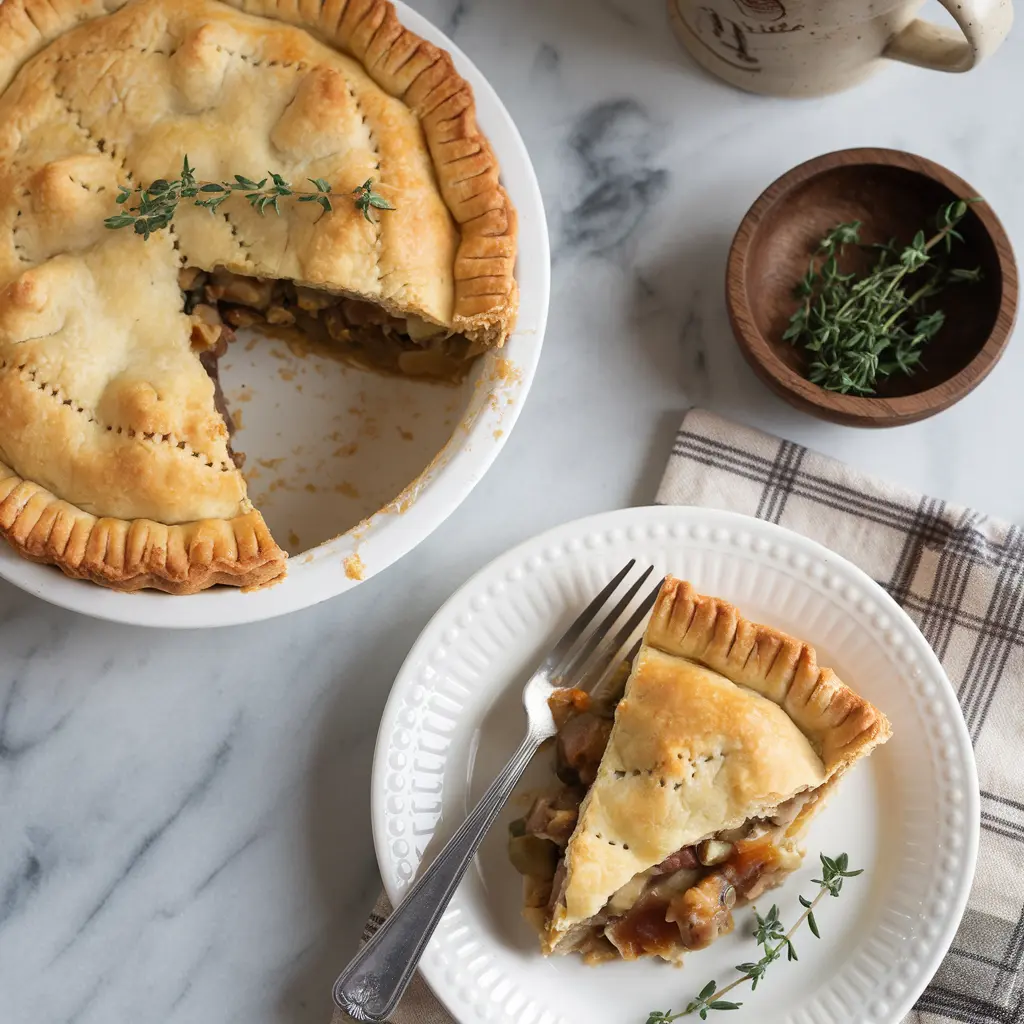Chicken pot pie is the ultimate comfort food, celebrated for its hearty, savory filling and flaky golden crust. Whether you enjoy it as a family dinner centerpiece or a quick lunch option, its rich history and versatile nature make it a cherished dish worldwide. This article dives deep into the origins, preparation, and creative twists of chicken pot pie, offering everything you need to know to master this beloved recipe in your kitchen.
Table of contents
The History of Chicken Pot Pie
Chicken pot pie is a dish deeply rooted in culinary tradition, embodying comfort and practicality. Its history spans centuries and continents, evolving from humble beginnings to the widely loved classic we know today.
Origins and Cultural Significance
The origins of chicken pot pie can be traced back to ancient times. The concept of a savory pie filled with meats and vegetables is believed to have originated with the Greeks and Romans. They created simple pastries stuffed with fillings, often as a means of preserving food. The technique of encasing ingredients in dough not only extended shelf life but also served as a portable meal for soldiers and travelers.
During the Middle Ages, the dish gained popularity in Europe. English cooks began refining the recipe, filling pies with poultry and other meats, along with a variety of vegetables. The term “pot pie” emerged as a reference to the method of cooking it in a pot with a crust that acted as both a lid and a part of the meal. These pies were often rich and decadent, reflecting their association with feasts and special occasions.
Variations Across the Globe
As chicken pot pie made its way to the New World, it underwent further transformation. In colonial America, the dish became a staple due to its versatility and the availability of fresh, local ingredients. Early settlers adapted the recipe using native produce like corn and beans, making it a quintessentially American dish.
Globally, variations of pot pies exist under different names and styles. In France, the vol-au-vent offers a more delicate, puff pastry approach. Australians and New Zealanders favor meat pies with hearty fillings similar to pot pies. In India, samosas can be seen as a cousin to the pot pie, featuring spiced fillings in a flaky crust. Each culture’s take reflects its unique palate while maintaining the comforting essence of the dish.
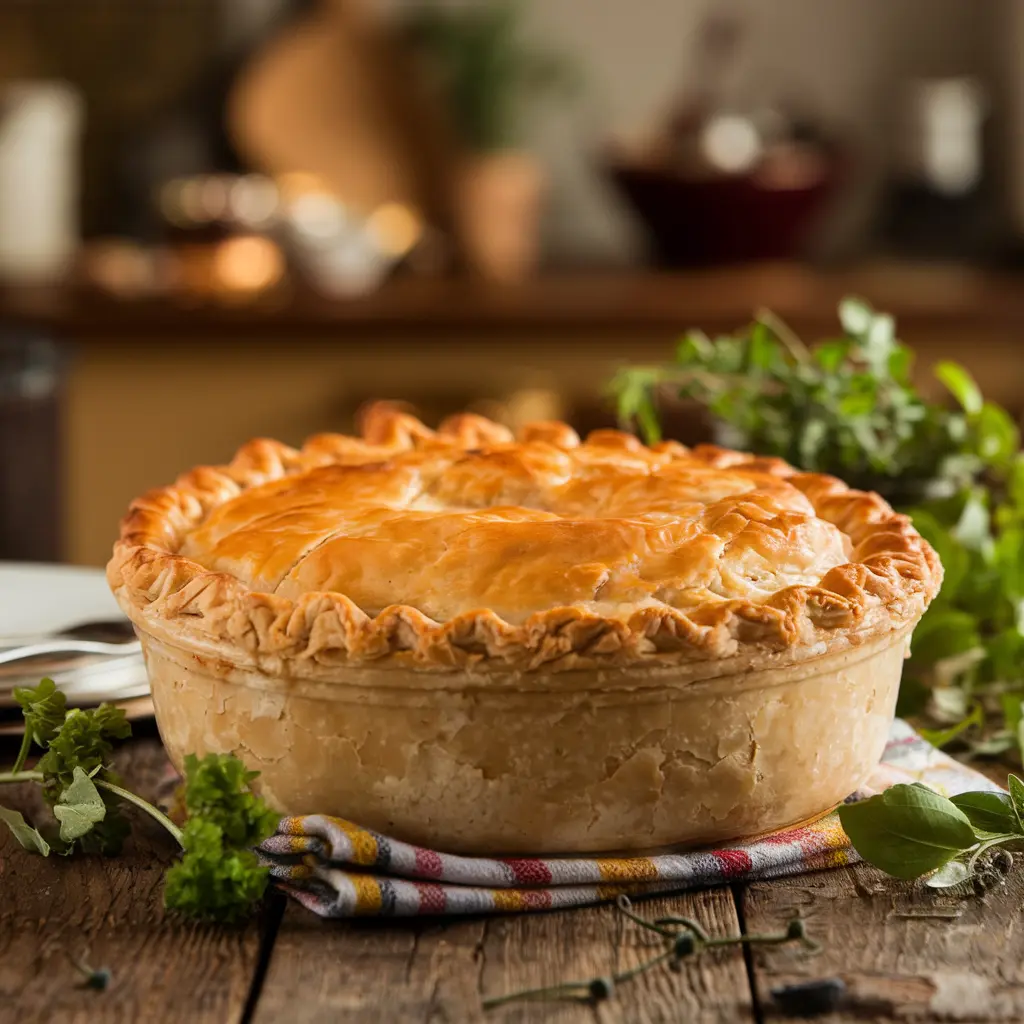
Evolution in the Modern Kitchen
In recent decades, chicken pot pie has transitioned from a traditional Sunday dinner dish to a convenient, everyday meal. Innovations in the food industry have led to frozen pot pies, making the dish accessible to those with limited time for home cooking. Despite this convenience, the homemade version remains a favorite for its unparalleled taste and texture.
Modern recipes often include twists such as gourmet ingredients, alternative crusts, or health-conscious adaptations. This evolution ensures chicken pot pie stays relevant and appealing across generations.
Ingredients for a Traditional Chicken Pot Pie
The beauty of chicken pot pie lies in its simplicity and adaptability. A classic recipe relies on a handful of wholesome ingredients, carefully selected to create a dish that’s rich, satisfying, and full of flavor.
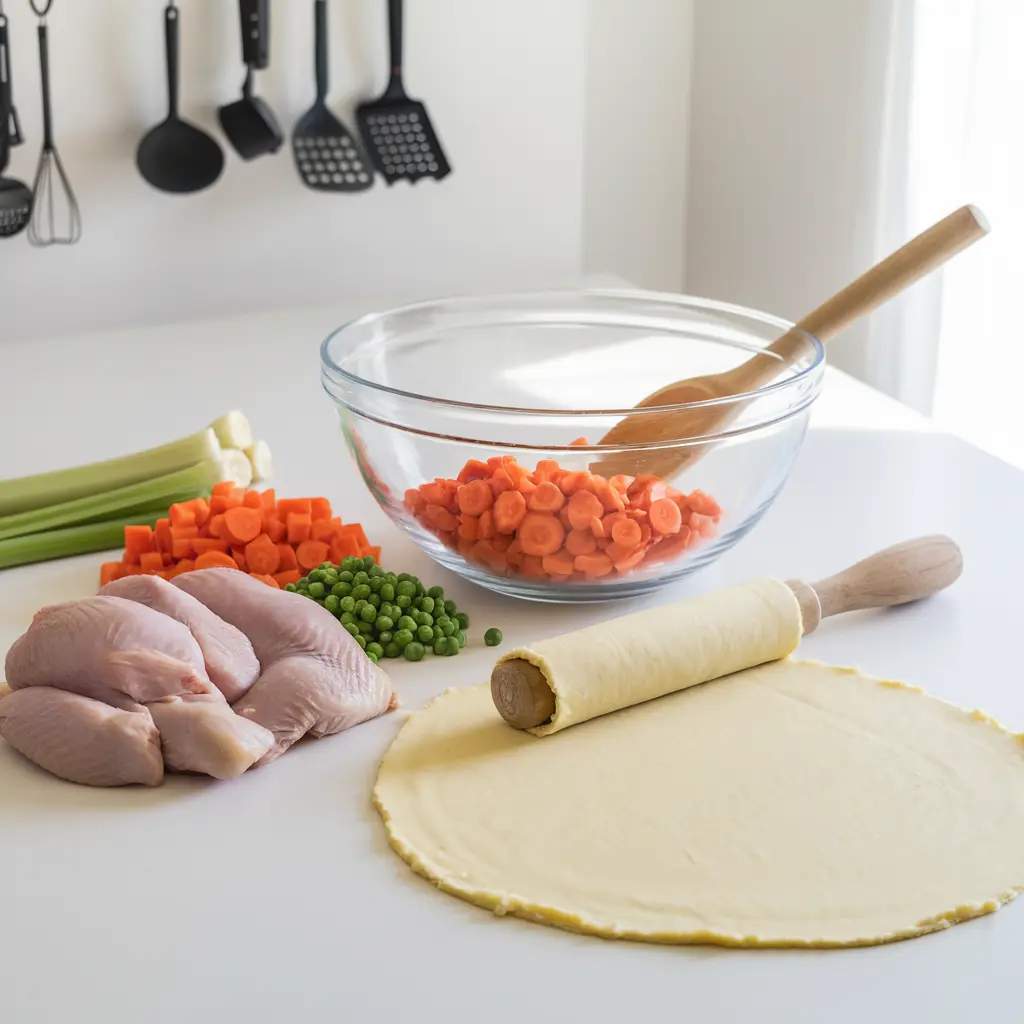
Key Ingredients for Authenticity
To achieve the comforting and traditional taste of chicken pot pie, these key ingredients are essential:
- Chicken: The heart of the dish. Fresh, cooked chicken breast or thigh meat works best for its tenderness and rich flavor. Rotisserie chicken is a convenient alternative that doesn’t compromise taste.
- Vegetables: A classic mix typically includes carrots, peas, and celery, providing a balance of sweetness, texture, and earthiness.
- Creamy Sauce: The sauce is the soul of the filling, made with a base of butter, flour, chicken broth, and heavy cream. It ties all the ingredients together, creating a luscious consistency.
- Pie Crust: A flaky, buttery crust crowns the dish, delivering the perfect balance of crispness and richness. Some recipes also include a bottom crust for a double-crust pie.
- Seasonings: Salt, pepper, thyme, and parsley are traditional seasonings that elevate the flavors without overpowering the dish.
Selecting Fresh and High-Quality Components
Quality ingredients can make all the difference in a homemade chicken pot pie. Here are some tips:
- Chicken: Use free-range or organic chicken for a more robust flavor. Cooking the chicken yourself allows you to use the drippings in your sauce for added depth.
- Vegetables: Opt for fresh, locally sourced vegetables when possible. Frozen vegetables can also work in a pinch but may require draining to prevent excess moisture.
- Dairy: Full-fat cream and butter ensure a rich, silky sauce. Avoid low-fat substitutes, as they can lead to a watery filling.
- Crust: Store-bought pie crusts are convenient, but a homemade crust made from scratch offers superior taste and texture.
Substitutions for Dietary Preferences
Chicken pot pie is a versatile dish, easily adapted to suit various dietary needs:
- For Gluten-Free: Swap out traditional flour in the sauce and crust with gluten-free alternatives such as almond or rice flour.
- For Dairy-Free: Use plant-based butter and cream substitutes like coconut milk or almond milk to create a creamy filling.
- For Low-Carb or Keto: Replace the pie crust with a cauliflower crust or skip it altogether, baking the filling in ramekins topped with cheese.
- For Vegetarian: Replace chicken with hearty vegetables like mushrooms, sweet potatoes, and zucchini, or use plant-based meat substitutes.
Balancing Nutrition and Flavor
Chicken pot pie can be hearty while still being balanced. Include nutrient-dense vegetables like kale or spinach to boost vitamins and minerals. Reducing salt and using unsalted chicken stock allows for more control over sodium content. For a lighter option, try a yogurt-based sauce instead of heavy cream.
Step-by-Step Guide to Making Chicken Pot Pie
Making a chicken pot pie from scratch may seem daunting, but with a clear plan, the process becomes straightforward and rewarding. Follow these steps to create a delicious, homemade version of this classic dish.
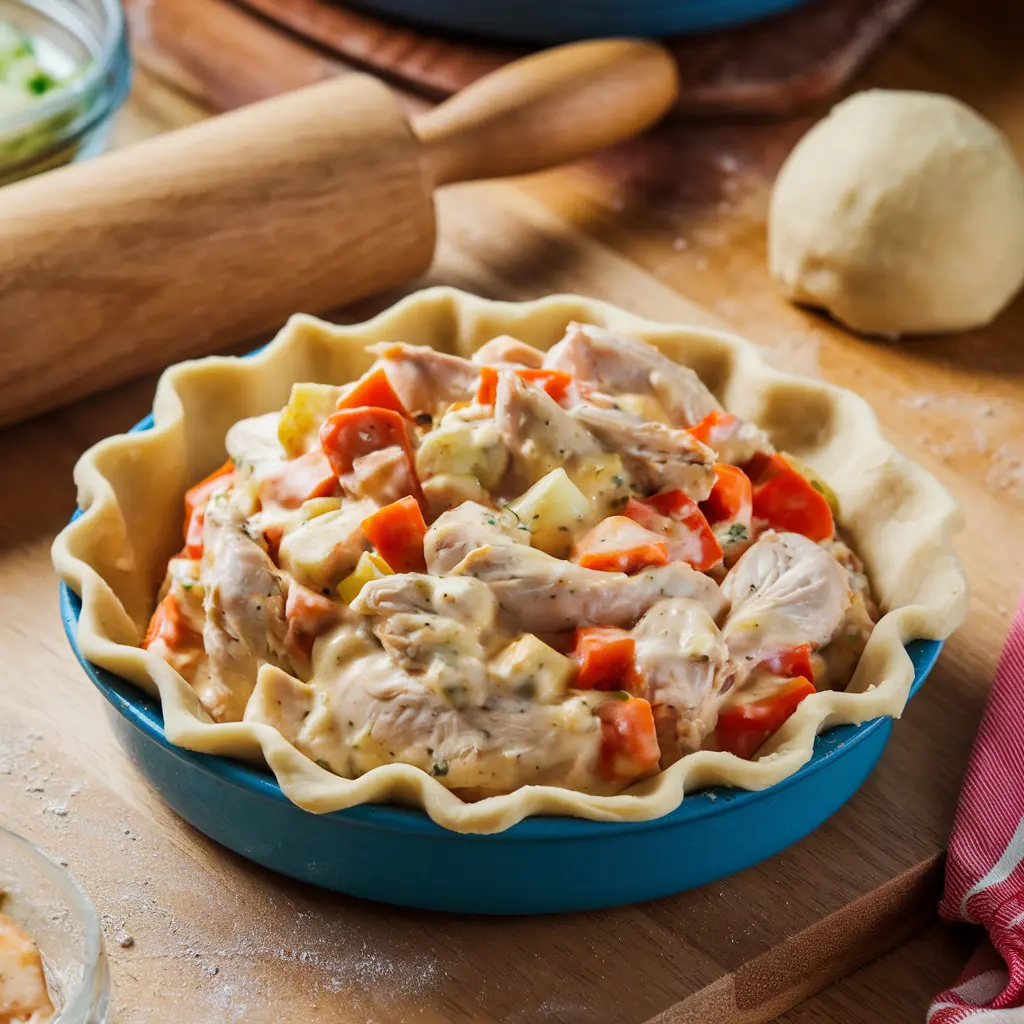
Preparing the Chicken and Vegetables
- Cooking the Chicken:
- Start by boiling or roasting chicken breasts or thighs until fully cooked. Season lightly with salt and pepper.
- Let the chicken cool slightly, then shred or dice it into bite-sized pieces. Set aside.
- Prepping the Vegetables:
- Dice carrots, celery, and onions into small, uniform pieces to ensure even cooking.
- If using frozen peas or corn, allow them to thaw slightly.
- For added flavor, consider sautéing the vegetables in a bit of butter or oil until they are tender but not fully cooked. This step enhances their natural sweetness.
Making the Creamy Sauce
- Create a Roux:
- In a large saucepan, melt 4 tablespoons of butter over medium heat. Stir in 4 tablespoons of all-purpose flour, whisking constantly until the mixture turns a light golden brown.
- Add the Liquid:
- Gradually pour in 2 cups of chicken broth while whisking to prevent lumps. Follow with 1 cup of heavy cream for richness.
- Cook the mixture over medium heat until it thickens, about 5-7 minutes.
- Season the Sauce:
- Stir in salt, black pepper, and a pinch of thyme or rosemary. Add a dash of garlic powder for extra flavor, if desired.
- Fold in the cooked chicken and vegetables, ensuring they are evenly coated in the creamy sauce.
Crafting the Perfect Pie Crust
- For Homemade Crust:
- Combine 2 ½ cups of flour, 1 teaspoon of salt, and 1 teaspoon of sugar in a bowl. Cut in 1 cup of cold, cubed butter until the mixture resembles coarse crumbs.
- Add 6-8 tablespoons of ice water, one tablespoon at a time, mixing until the dough just comes together.
- Divide the dough into two disks, wrap in plastic, and refrigerate for at least 30 minutes.
- For Store-Bought Crust:
- Allow the crust to thaw slightly before rolling it out on a floured surface. Ensure it’s large enough to fit your pie dish.
Assembling the Pot Pie
- Prepare the Pie Dish:
- Roll out one disk of dough (or the thawed crust) and line the bottom of a greased pie dish. Trim any excess, leaving a slight overhang.
- Add the Filling:
- Pour the creamy chicken and vegetable mixture into the crust, spreading it evenly.
- Top with the Crust:
- Roll out the second disk of dough and carefully lay it over the filling. Trim the edges and crimp them together using a fork or your fingers for a decorative finish.
- Cut small slits in the top crust to allow steam to escape during baking.
Baking to Golden Perfection
- Preheat the Oven:
- Heat your oven to 400°F (200°C).
- Bake the Pie:
- Place the assembled pie on a baking sheet to catch any spills. Bake for 30-35 minutes, or until the crust is golden brown and the filling is bubbling through the slits.
- Rest Before Serving:
- Allow the pie to cool for 10-15 minutes before serving. This helps the filling set and prevents burns from hot steam.
Tips and Tricks for the Perfect Chicken Pot Pie
Creating the ultimate chicken pot pie involves more than just following a recipe. With these expert tips, you can elevate your dish to perfection, ensuring a balance of textures, flavors, and visual appeal.
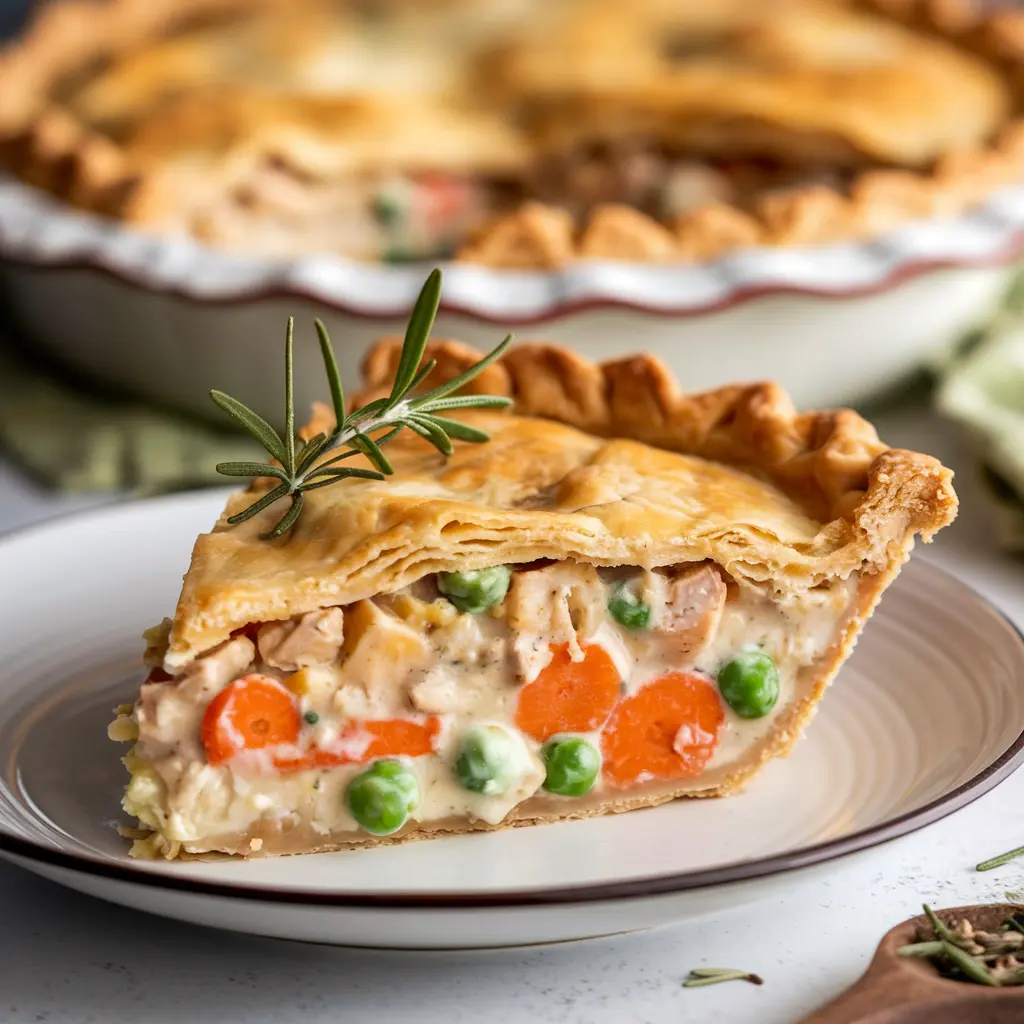
Achieving the Ideal Crust-to-Filling Ratio
- Balance the Layers:
- The perfect pot pie has a harmonious ratio of crust to filling. Avoid overfilling the pie dish to prevent spillage and ensure every bite has a good mix of flaky crust and savory filling.
- Double-Crust Delight:
- For those who love extra crust, consider lining the bottom of the pie dish with dough as well as adding a top crust. Pre-bake the bottom crust for 10 minutes to prevent sogginess.
- Consider Ramekins for Mini Pies:
- Use ramekins to make individual chicken pot pies, which can provide more control over portion sizes and crust distribution.
Ensuring a Golden and Flaky Crust
- Keep the Ingredients Cold:
- Cold butter or shortening is key to a flaky crust. If making the dough by hand, work quickly to prevent the butter from melting.
- Brush with an Egg Wash:
- A mixture of one egg yolk and a tablespoon of milk brushed over the crust before baking creates a beautiful, golden finish.
- Bake on the Lower Rack:
- Placing the pie dish on the oven’s lower rack ensures the bottom crust cooks through without becoming soggy.
- Ventilation Matters:
- Don’t skip the slits on the top crust; these allow steam to escape, preventing the filling from bubbling over and softening the crust.
Enhancing Flavors with Herbs and Spices
- Use Fresh Herbs:
- Fresh thyme, parsley, and rosemary can enhance the flavor of the filling. Add them during the sauce-making stage for maximum infusion.
- Spice It Up:
- For a subtle kick, include a pinch of paprika or cayenne pepper. Smoked paprika can add a layer of depth and complexity to the dish.
- Add Aromatics:
- Sautéing garlic, onions, or leeks as a base for the filling adds a rich, aromatic quality to the pot pie.
Making It Ahead Without Compromising Quality
- Prepping the Filling:
- Prepare the filling a day in advance and store it in an airtight container in the refrigerator. This saves time on baking day and allows the flavors to meld.
- Assembling Before Baking:
- Assemble the pie but hold off on baking. Wrap the unbaked pie tightly in plastic wrap and refrigerate for up to 24 hours or freeze for longer storage. Bake directly from frozen, adding a few extra minutes to the baking time.
- Reheating Without Drying Out:
- Cover leftover slices with foil and reheat in a 350°F (175°C) oven to maintain moisture and crispness.
Troubleshooting Common Issues
- Soggy Bottom Crust:
- Avoid by pre-baking the bottom crust or brushing it with a thin layer of egg white before adding the filling.
- Runny Filling:
- Ensure your sauce thickens adequately before pouring it into the crust. Adding a slurry of cornstarch and water can help if needed.
- Overcooked Crust:
- Use foil to cover the edges of the crust during baking if they brown too quickly.
With these tips, your chicken pot pie will be a culinary masterpiece, delighting everyone at the table with its perfect combination of textures and flavors.
Variations and Creative Twists on Chicken Pot Pie
One of the most appealing aspects of chicken pot pie is its adaptability. While the classic recipe is a time-honored favorite, there are countless ways to reimagine the dish to suit different tastes, occasions, and dietary needs. Here are some creative variations to inspire your culinary experiments.
Mini Chicken Pot Pies
- Perfect for Individual Servings:
- Mini chicken pot pies are ideal for dinner parties or meal prepping. Use muffin tins or ramekins to create individual portions.
- Easy Assembly:
- Line each cup or ramekin with pie crust or puff pastry, add the filling, and top with a smaller round of dough. Press the edges to seal, and bake as you would a full-sized pie.
- Portable and Fun:
- These smaller versions are great for picnics, school lunches, or as a grab-and-go snack. Kids particularly enjoy their personal-sized pies.
Gluten-Free and Vegan Adaptations
- Gluten-Free Pot Pie:
- Swap out the traditional wheat crust with gluten-free alternatives, such as almond flour crusts or a blend of gluten-free flours.
- Use cornstarch or a gluten-free flour blend to thicken the sauce.
- Vegan Pot Pie:
- Replace chicken with hearty vegetables like mushrooms, lentils, or chickpeas for a protein boost.
- Use plant-based butter and non-dairy milk, such as almond or oat milk, for the sauce. The crust can be made vegan by substituting traditional butter with coconut oil or vegan margarine.
- Flavor Boosts:
- Add nutritional yeast to the filling for a cheesy, umami flavor, or toss in a handful of chopped fresh herbs like dill or basil for freshness.
Using Alternative Proteins
- Turkey Pot Pie:
- A popular alternative for Thanksgiving leftovers, turkey pot pie follows the same recipe, substituting cooked turkey for chicken. Add cranberries or stuffing for a seasonal twist.
- Seafood Pot Pie:
- Combine shrimp, scallops, or crab with a creamy, herb-infused sauce. Swap chicken broth for seafood stock to complement the flavors.
- Vegetarian Protein Options:
- Incorporate tofu, tempeh, or seitan for a meat-free alternative. These proteins absorb flavors well and provide the same satisfying texture as chicken.
Unique Crust Alternatives
- Puff Pastry:
- Using puff pastry instead of traditional pie crust creates a light, crispy topping. It’s an excellent choice for those who prefer a flakier texture.
- Mashed Potato Topping:
- Replace the crust entirely with a layer of creamy mashed potatoes, similar to a shepherd’s pie. For added texture, sprinkle grated cheese and breadcrumbs on top before baking.
- Phyllo Dough:
- Thin sheets of phyllo dough provide a crispy, layered topping. Brush each sheet with butter before layering them over the filling.
International Twists on Chicken Pot Pie
- Curry-Spiced Pot Pie:
- Add curry powder, turmeric, and coconut milk to the filling for a bold, aromatic twist inspired by Indian flavors.
- Mexican-Inspired Pot Pie:
- Incorporate ingredients like black beans, corn, diced tomatoes, and taco seasoning. Use a cornbread topping for an authentic touch.
- Mediterranean Version:
- Include feta cheese, olives, and sun-dried tomatoes in the filling. Use olive oil in the crust for a Mediterranean flair.
Fun Shapes and Designs
- Decorative Crusts:
- Use cookie cutters to create shapes from the dough and place them on top of the pie for a festive look.
- Braided Edges:
- For an elegant presentation, braid strips of dough and place them along the edges of the pie.
- Seasonal Themes:
- Tailor your crust design to the season, such as leaf-shaped cutouts for fall or heart shapes for Valentine’s Day.
These variations and creative twists showcase the incredible versatility of chicken pot pie. Whether you’re sticking to tradition or trying something new, there’s a version for every palate and occasion.
Serving and Pairing Chicken Pot Pie
Chicken pot pie is a meal that shines on its own, but thoughtful presentation and complementary side dishes can elevate it to an extraordinary dining experience. From serving tips to perfect pairings, this section explores how to enhance your chicken pot pie meal.
Presentation Ideas for a Stunning Dish
- Classic and Rustic:
- Serve the pie straight from the baking dish for a homey, rustic feel. Use a cast-iron skillet for added charm and even heating.
- Individual Servings:
- Present personal-sized pot pies in ramekins or small pie dishes. This adds elegance and convenience, especially for formal gatherings.
- Decorative Touches:
- Garnish the baked pie with a sprig of fresh parsley, thyme, or rosemary for a pop of color and aroma.
- If you’ve used decorative crust cutouts, highlight them by lightly brushing with an egg wash before baking to ensure they are golden and appealing.
Perfect Side Dishes to Complement Chicken Pot Pie
While chicken pot pie is hearty enough to be a meal on its own, pairing it with light and flavorful sides creates a well-rounded dining experience. Here are some excellent options:
- Fresh Salads:
- A crisp green salad with a tangy vinaigrette can balance the richness of the pot pie. Try an arugula and pear salad with walnuts and blue cheese for a sophisticated touch.
- Roasted Vegetables:
- Oven-roasted Brussels sprouts, carrots, or asparagus with a drizzle of olive oil and seasoning add texture and variety to the meal.
- Soups:
- A light soup, like tomato basil or butternut squash, serves as a comforting starter to complement the savory pie.
- Bread and Rolls:
- Soft dinner rolls or a loaf of crusty bread are perfect for soaking up any leftover creamy filling.
- Pickled Vegetables:
- A side of pickles or a tangy vegetable slaw can cut through the pie’s richness with refreshing acidity.
Beverage Pairings for Every Occasion
Pairing the right beverage with chicken pot pie enhances its flavors and makes the meal even more enjoyable. Here are some suggestions:
- Wine:
- A Chardonnay with buttery notes pairs beautifully with the creamy filling. For red wine lovers, a light Pinot Noir complements the chicken without overpowering it.
- Beer:
- Opt for a Pale Ale or Amber Lager, which balances the savory filling and flaky crust with their malty sweetness.
- Non-Alcoholic Options:
- Lemon-infused sparkling water or a lightly sweetened iced tea offers a refreshing contrast to the richness of the pie.
- Seasonal Drinks:
- In colder months, pair with a warm mulled cider or hot toddy for comfort. In summer, a chilled lemonade or sangria adds a refreshing twist.
Styling the Table for a Cozy Meal
- Theme the Setting:
- For a rustic look, use wooden platters, checkered tablecloths, and mason jar glasses. For a more formal occasion, go for elegant dinnerware with muted tones.
- Lighting:
- Soft, warm lighting creates an inviting atmosphere. Use candles or fairy lights for an added touch of charm.
- Serve Family-Style:
- Place the chicken pot pie at the center of the table and allow guests to serve themselves, fostering a communal and welcoming vibe.
Chicken pot pie is a versatile centerpiece that pairs well with many sides and beverages. Whether served casually for a family dinner or elegantly for a special occasion, these serving and pairing ideas ensure it becomes the star of your meal.
Storing and Reheating Chicken Pot Pie
Chicken pot pie is a dish that stores well, making it ideal for meal prep or enjoying leftovers. To maintain its delicious flavors and textures, it’s essential to store and reheat it properly. This section provides tips on refrigeration, freezing, reheating, and creative ways to repurpose leftovers.
Best Practices for Refrigeration and Freezing
- Refrigerating Chicken Pot Pie:
- How to Store: Cover the pot pie tightly with aluminum foil, plastic wrap, or an airtight lid to prevent moisture loss and odor absorption.
- Shelf Life: Refrigerated chicken pot pie can last up to 3-4 days.
- Freezing Chicken Pot Pie:
- For Unbaked Pies: Assemble the pie as directed but skip the baking. Wrap it tightly in plastic wrap and then aluminum foil to prevent freezer burn. Label with the date for reference.
- For Baked Pies: Allow the pie to cool completely before freezing. Cut it into portions for convenience, or freeze it whole. Store in a freezer-safe container or wrap securely.
- Shelf Life: Frozen chicken pot pie can last up to 2-3 months.
- Thawing Frozen Pot Pie:
- Transfer the frozen pie to the refrigerator and let it thaw overnight. If you’re short on time, use the defrost setting on your microwave, but proceed cautiously to avoid uneven thawing.
Reheating for Maximum Freshness
- Reheating in the Oven:
- Whole Pie: Preheat the oven to 350°F (175°C). Cover the pie loosely with foil to prevent the crust from overbrowning and heat for 20-30 minutes (longer if frozen).
- Individual Slices: Place slices on a baking sheet and cover with foil. Heat for 10-15 minutes until warmed through.
- Reheating in the Microwave:
- Tips for Success: Place a damp paper towel over the slice to prevent it from drying out. Heat in 30-second increments, checking for even warming.
- Drawback: The crust may lose its crispness when microwaved.
- Reheating on the Stovetop:
- For the Filling Only: If you’ve stored only the filling, reheat it in a saucepan over medium heat, stirring occasionally. For added creaminess, you can stir in a splash of milk or cream.
Creative Ways to Repurpose Leftovers
- Turn It into a Casserole:
- Transfer leftover filling into a baking dish and top with mashed potatoes or breadcrumbs. Bake until golden for a fresh take on the leftovers.
- Make a Pot Pie Soup:
- Add more chicken broth or milk to the filling and heat it on the stove for a creamy soup. Serve with crusty bread or crackers.
- Chicken Pot Pie Sandwich:
- Use the filling as a topping for toasted bread or as a filling for sandwiches or wraps.
- Stuffed Bell Peppers:
- Hollow out bell peppers, fill them with the leftover chicken pot pie mixture, and bake at 375°F (190°C) for 20-25 minutes.
Avoiding Common Storage Mistakes
- Storing While Still Warm:
- Let the pie cool completely before storing it to prevent condensation, which can make the crust soggy.
- Using the Wrong Containers:
- Always use airtight or freezer-safe containers to maintain freshness and prevent freezer burn.
- Overheating:
- Reheat just until warm to preserve the dish’s texture and prevent drying out the filling.
By following these storage and reheating tips, you can enjoy chicken pot pie at its best even after a few days or weeks. Plus, with creative leftover ideas, nothing goes to waste, and your meals remain exciting.
FAQs About Chicken Pot Pie
Chicken pot pie is a beloved dish, but home cooks often have questions about its preparation, storage, and variations. Here are answers to some of the most frequently asked questions to help you achieve pot pie perfection.
Can I Use Store-Bought Crust for Chicken Pot Pie?
Yes, store-bought crusts are a convenient option and work well for chicken pot pie. Choose a high-quality refrigerated or frozen crust for the best results. Puff pastry is also a popular alternative for a flaky, buttery topping.
How Do I Prevent a Soggy Bottom Crust?
To avoid a soggy bottom crust:
- Pre-bake the bottom crust for 10 minutes before adding the filling.
- Brush the crust with an egg white or light layer of melted butter to create a barrier.
- Ensure your filling is not too watery by properly thickening the sauce during cooking.
What Is the Best Way to Thicken the Filling?
The most common way to thicken chicken pot pie filling is by making a roux. This involves cooking equal parts butter and flour before adding chicken broth and cream. Alternatively, a slurry made of cornstarch and water can be added directly to the simmering sauce to achieve the desired consistency.
Can I Make Chicken Pot Pie in Advance?
Yes, chicken pot pie can be prepared ahead of time:
- Unbaked Version: Assemble the pie, wrap it tightly, and refrigerate for up to 24 hours or freeze for up to 3 months.
- Baked Version: Cook the pie completely, let it cool, and store it in the refrigerator for up to 4 days or the freezer for 2-3 months. Reheat as needed.
What Can I Substitute for Heavy Cream in the Filling?
If you’re looking for lighter or dairy-free alternatives to heavy cream, try these substitutes:
- For a lighter option: Use whole milk or half-and-half for a less rich filling.
- For dairy-free: Coconut milk, almond milk, or cashew cream work well and still provide a creamy texture.
How Do I Know When My Chicken Pot Pie Is Done?
A fully baked chicken pot pie should have a golden-brown crust and bubbling filling visible through the slits in the crust. For accuracy, check the internal temperature with a food thermometer; it should reach 165°F (74°C).
Can I Use Leftover Cooked Chicken?
Absolutely! Leftover roasted, grilled, or rotisserie chicken is perfect for pot pie. Using precooked chicken saves time and ensures the filling is rich and flavorful.
What Are Some Creative Ways to Customize Chicken Pot Pie?
You can customize chicken pot pie to suit different tastes and occasions:
- Add extra vegetables: Incorporate mushrooms, spinach, or broccoli for added nutrients.
- Experiment with seasonings: Use smoked paprika, curry powder, or garlic to add unique flavors.
- Try alternative proteins: Substitute turkey, seafood, or tofu for a creative twist.
Is Chicken Pot Pie Healthy?
While traditional chicken pot pie is rich and hearty, you can make it healthier by:
- Using lean chicken breast and reducing butter in the crust.
- Adding more vegetables for fiber and nutrients.
- Opting for a lighter crust, such as phyllo dough or a cauliflower crust.
How Do I Fix a Runny Filling?
If your filling is too runny:
- Simmer the mixture longer to allow excess liquid to evaporate.
- Stir in a cornstarch or flour slurry for quick thickening.
- Avoid overloading the pie with frozen vegetables, as they release water during baking.
Can I Freeze Individual Slices?
Yes, freezing individual slices is a great way to store leftovers. Wrap each slice tightly in plastic wrap and then foil, or place them in freezer-safe containers. Reheat in the oven or microwave for a quick, convenient meal.
These FAQs should address the most common concerns about making and enjoying chicken pot pie. With these insights, you’ll have the confidence to prepare this comforting dish with ease.
Conclusion
Chicken pot pie is more than just a meal; it’s a timeless symbol of comfort and warmth. Its flaky crust, savory filling, and versatility make it a favorite across cultures and generations. Whether you’re honoring tradition with a classic recipe or experimenting with creative variations, chicken pot pie remains a dish that brings people together.
From its ancient origins to its modern adaptations, chicken pot pie showcases how simple ingredients can create a memorable dining experience. With the detailed tips and techniques outlined in this guide, you’re well-equipped to master the art of chicken pot pie, ensuring that every bite is a delightful mix of textures and flavors.
The next time you’re looking for a hearty, satisfying dish, remember the enduring charm of chicken pot pie. It’s a meal that not only nourishes the body but also comforts the soul perfect for any occasion, any time of year.

